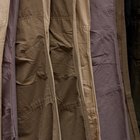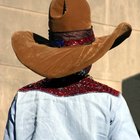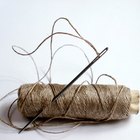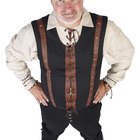
Knitting a V-neck sweater can be a challenging process, depending on how much experience you have knitting. If you are working from a pattern, the process can be made easier, but it still requires preparation and a certain amount of skill. The directions in this article are for a raglan sweater, which is knit in one piece from the neck down.
Measure the wearer of the sweater to determine the size of the sweater and how much yarn you will need to knit it. The measurements you will need are the neck size, collar to underarm, sleeve length, chest size, body length and wrist size.
Determine the gauge. If you are not using a pattern, you will need to knit a gauge swatch. Cast on 20 stitches and work in your desired stitch for about 4 inches. This becomes the swatch. Measure the width so you can calculate the gauge. The formula for this is the amount of stitches (20) divided by the width of the swatch.
Calculate the stitches around the neck. Multiply the neck measurement by the gauge to determine how many stitches you will need around the neck. Follow this by calculating the back stitches, which is done by multiplying the number of neck stitches by 0.33. The amount of sleeve stitches is then calculated by multiplying the number of back stitches by 0.25. The increase stitches is always 8.
Finish your calculations by determining the amount of front stitches. This is done by taking the total amount of neck stitches and subtracting the combined total of the back stitches, two sleeve stitches and the fixed increase stitches.
Cast-on. Begin on the right side by knitting two stitches and place a marker, then knit 16 and place a marker, knit 24 stitches and place a marker, knit 16 stitches and place a marker, knit 2 stitches and place a marker. Purl the next row on the opposite side. Once you return to the right side increase on either side of the stitch marker.
Continue increasing. Once you have knit the first few rows, the V-neck will need to be shaped. Depending on how deep you want the V-neck to be, the amount you increase will change accordingly. For a deeper neck you should increase every third or fourth row. A shallow neck will require you to increase on every other row. Continue to increase until the front and back of the sweater have the same amount of stitches.
Continue knitting until you reach the sleeve holes. Once you have your desired arm hole depth, knit the front section until you reach the stitch markers on the right sleeve. Place the right sleeve stitches onto a stitch holder and cast on half the number of stitches needed for your required chest measurement. This can be calculated by dividing the number of back stitches with the gauge.
Continue knitting until you have reached the length measured earlier. The body of the sweater is now complete.
Place the sleeve stitches on needles and pick up the number of stitches that you cast on for the chest measurement. This will become the sleeve. Once you have knit the desired sleeve length, repeat the process for the other sleeve.
Finish by weaving in any loose ends with a tapestry needle.
Related Articles

How to Make a Jockstrap

How to Alter the Waist of Pants to Make ...

Directions for Extending the Waistline ...

How to Sew a Gusset on a Sleeve

How to Sew Turtleneck Sweaters Into ...

How to Cut the Neckline of a Hoodie

How to Make a Clerical Shirt

How to Take Out Wrinkles From a Merino ...

How to Monogram Shirt Cuffs

How to Make Darts in Shirts

How to Hem a Cardigan Sweater

How to Decrease the Padding in a Bra

How to Alter a Cheerleading Skirt

How to Sew a Western Shirt Pattern

How to Stretch Wool After Shrinking It

How to Take Measurements for Tailoring

How to Use a Sewing Machine to Make a ...

How to Invisibly Mend Moth Damage in a ...

How to Cut a T-Shirt Into a Tank Top ...

How to Make a Medieval Jerkin
References
Writer Bio
Marc Wright has been writing professionally since 2004. He has been published in the literary magazine "Things," as well as the student newspaper "The Demon" as a music critic. In 2009 Wright graduated from De Montfort University of Leicester with a Bachelor of Arts in creative writing and English.
Photo Credits
Hemera Technologies/AbleStock.com/Getty Images